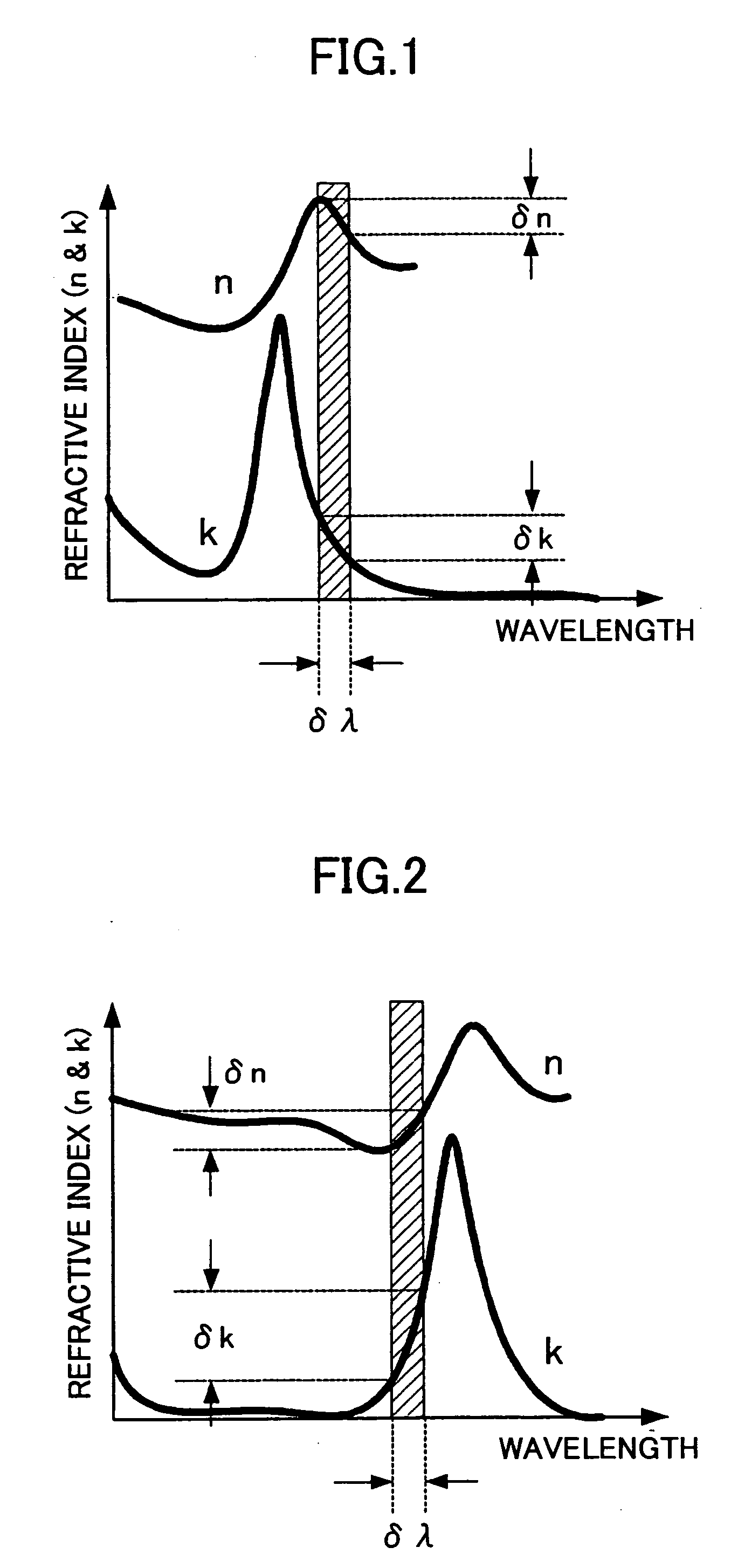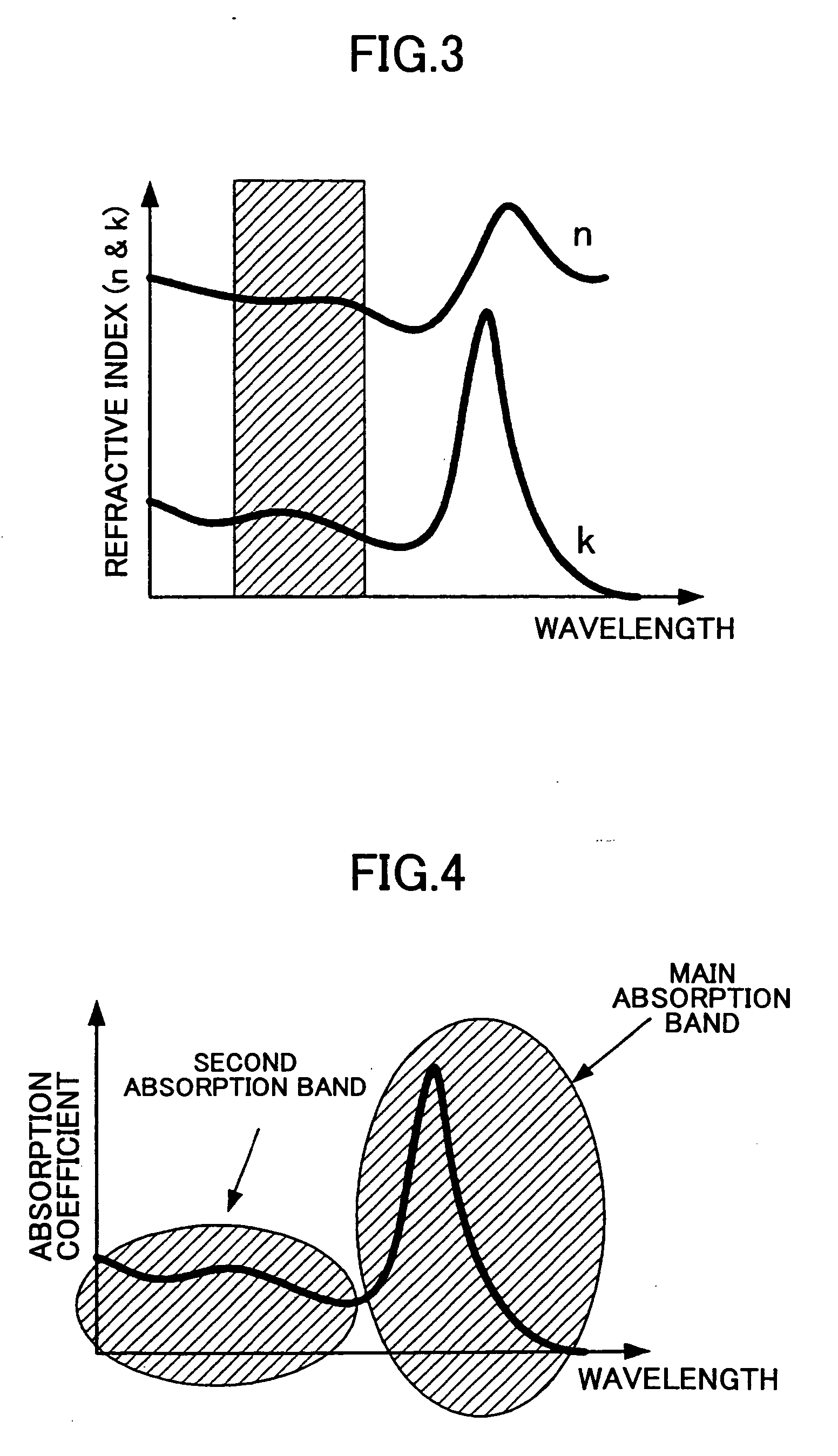Write-once-read-many optical disk having low-to-high recording property accommodating short wavelength recording
a technology of optical disks and writing machines, applied in the field of writeoncereadmany (worm) optical disks, can solve the problems of reducing the absorption coefficient (light absorption function), reducing the refractive index, and organic materials that do not have a large refractive index
- Summary
- Abstract
- Description
- Claims
- Application Information
AI Technical Summary
Benefits of technology
Problems solved by technology
Method used
Image
Examples
example 1
[0143] In this example, a write-only-read-many optical recording medium including a substrate (having track guide grooves with a groove depth of 55 nm) on which an organic material layer (formed with a organic pigment material and having an average thickness of approximately 60 nm), a Ag reflection layer (having a thickness of 150 nm), and a protective layer (formed with a UV curing resin and having a thickness of 5 μm) are layered in this order. The organic pigment material, having a structure shown below in [Formula 1], has an absorption spectrum that is suitable for CD-R, as shown in FIG. 5.
[0144] This organic pigment material corresponds to the above-described organic material having a sufficient light absorption function accommodating the recording / reproduction wavelength and further corresponds to the above-described organic material having a main absorption band situated toward the long wavelength side with respect to the recording / reproduction wavelength range and a second ...
example 2
[0153] The second example is described for showing that the recording power for obtaining an optimum jitter can be reduced and that satisfactory jitter characteristics can be obtained by inserting a heat insulating layer (shown below in Table 1) between the pigment layer (organic material layer) and the reflection layer to the optical recording medium according to the first example of the present invention. Other than the heat insulating layer being inserted between the pigment layer (organic material layer) and the reflection layer, the configuration of the optical recording medium according to the second example of the present invention is the same as that the optical recording medium according to the first example of the present invention.
[0154] In the same manner as Example 1, the optimum recording power and the optimum jitter was evaluated by recording at the groove parts of the optical recording medium according to the second example of the present invention. The results are ...
example 3
[0158] In the third example, another write-only-read-many optical recording medium including a substrate (having track guide grooves with a groove depth of 55 nm) on which a light absorption layer (formed of SiC and having a thickness of 10 nm), an organic material layer (formed with a organic pigment material and having an average thickness of approximately 60 nm), a Ag reflection layer (having a thickness of 150 nm), and a protective layer (formed with a UV curing resin and having a thickness of 5 μm) are layered in this order. The organic pigment material, having a structure shown below in [Formula 2], has an absorption spectrum that is suitable for CD-R, as shown in FIG. 8.
[0159] The organic pigment material in the third example hardly has any absorption in the recording / reproduction wavelength range and corresponds to a material satisfying the above-described relation of “(light absorption function of organic material layer in recording / reproduction wavelength area)<(light ab...
PUM
| Property | Measurement | Unit |
|---|---|---|
| recording wavelength | aaaaa | aaaaa |
| recording wavelength | aaaaa | aaaaa |
| oscillation wavelength | aaaaa | aaaaa |
Abstract
Description
Claims
Application Information
 Login to View More
Login to View More - R&D
- Intellectual Property
- Life Sciences
- Materials
- Tech Scout
- Unparalleled Data Quality
- Higher Quality Content
- 60% Fewer Hallucinations
Browse by: Latest US Patents, China's latest patents, Technical Efficacy Thesaurus, Application Domain, Technology Topic, Popular Technical Reports.
© 2025 PatSnap. All rights reserved.Legal|Privacy policy|Modern Slavery Act Transparency Statement|Sitemap|About US| Contact US: help@patsnap.com



